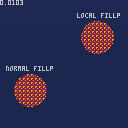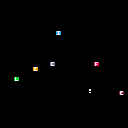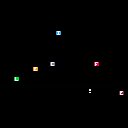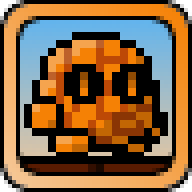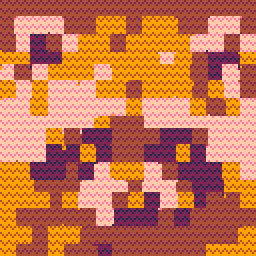I wanted to achieve this effect with fill patterns for a recent project I started so I figured I'd share it here incase anyone else is interested in using it.
The local fill pattern function is shifting each row/column in the fill pattern by given x and y amount. It's using binary arithmetics and a cache of shift masks.
Here's the original code for version 1.0, takes 126 tokens:
EDIT:
With great contributions and improvements by Felice here's a both faster, smaller and more API consistent version 2.0, takes 87 tokens:
Hope you find it useful!

Excellent work. I've been wondering about how to implement this idea since fillp was released.

Good idea!
I refined your methods and took a fair chunk of the math and tokens off (now 80 tokens). Here's my version:
_fillp_xmask_lo={[0]=0xffff,0x7777,0x3333,0x1111}
_fillp_xmask_hi={[0]=0x0000,0x8888,0xcccc,0xeeee}
function fillp_local(x,y,p)
x=band(x,3)
local p16=flr(p)
local p32=rotr(p16+lshr(p16,16),band(y,3)*4+x)
return fillp(p-p16+flr(band(p32,_fillp_xmask_lo[x])+band(rotl(p32,4),_fillp_xmask_hi[x])))
end
|
And a demo thereof:

Thanks Felice,
this is a very nice addition. Would you mind if I edit the original post with an update of your refined version?
Edit: I just noticed however, that your version doesn't respect the additional (floating point?) bits you can provide to a pattern to specify ignoring the second color from drawing. For instance, this pattern would not draw as intended:
local pattern=0b1110100110011010.1 fillp_local(x,y,pattern) |
Once that is fixed I'll update the OP with your improvements, given you're alright with that.
Regards.

Do as you like with the code, I marked it creative commons for that reason. :)
It should be retaining the fractional transparency bit. I don't remember testing that so I may have failed to do it right. That's what the p-p16 is where I send the value on to fillp--the original pattern minus the integer bits, leaving the fractional bits, which are added to the resulting shifted pattern.

Oh, okay, I see what I did.
When I was rearranging code, I accidentally moved that p-p16 inside of the flr(), effectively deleting it.
Easy fix. See my original post for an updated version and a demo that <gasp> actually tests the transparency support. ;)

Actually...
One option would be to write a flat-out replacement for fillp() that takes optional x,y args after the pattern and shifts the pattern if so. That would add to the API pretty seamlessly, while not adding complexity and still keeping backwards compatibility.
Something like this:
_fillp_xmask_lo={[0]=0xffff,0x7777,0x3333,0x1111}
_fillp_xmask_hi={[0]=0x0000,0x8888,0xcccc,0xeeee}
_fillp_original=fillp
function fillp(p,x,y)
if y then
x=band(x,3)
local p16=flr(p)
local p32=rotr(p16+lshr(p16,16),band(y,3)*4+x)
p+=flr(band(p32,_fillp_xmask_lo[x])+band(rotl(p32,4),_fillp_xmask_hi[x]))-p16
end
return _fillp_original(p)
end
|
It costs 7 more tokens, but it just feels more natural, and in keeping with the rest of the API, to extend an existing function. Other calls like map() and sspr() do similar things.
Obligatory demo:

Felice, this is a way better approach so I'll update the original post with your improvements. Thanks and great work!

Ah, nice. I like my demo for having my name in it, but yours definitely demonstrates the functionality better. ;)

67 tokens with more arithmetic, no tables, and an otherwise pointless local x (not counting tokens for backward compatibility defaults)
local _fillp = fillp
local function fillp(p, x, y)
p, x, y = p or 0, x or 0, y or 0 -- to maintain drop-in replacement compatibility with fillp(p)
local p16, x = flr(p), band(x, 3)
local f, p32 = flr(15 / 2 ^ x) * 0x1111, rotr(p16 + lshr(p16, 16), band(y, 3) * 4 + x)
return _fillp(p - p16 + flr(band(p32, f) + band(rotl(p32, 4), 0xffff - f)))
end |
and thanks to Felice's response on Discord, here it is with shl instead of ^, faster but two more tokens
local _fillp = fillp
local function fillp(p, x, y)
p, x, y = p or 0, x or 0, y or 0 -- to maintain drop-in replacement compatibility with fillp(p)
local p16, x = flr(p), band(x, 3)
local f, p32 = flr(15 / shl(1,x)) * 0x1111, rotr(p16 + lshr(p16, 16), band(y, 3) * 4 + x)
return _fillp(p - p16 + flr(band(p32, f) + band(rotl(p32, 4), 0xffff - f)))
end |

Felice, I am curious why your natural extension above shifts neither x nor y when y is not present? If we want a seamless extension shouldn't it still shift x?

I was just economizing. I figured anyone wanting to shift the pattern would probably provide both parameters and that a single parameter would generally be an accident.
It's entirely reasonable to want to work with just x though. I just didn't do it. Arbitrary.

I happened to come back and look at this. Isn't this:
flr(15 / shl(1,x)) * 0x1111 |
Just this?
flr(shr(15,x)) * 0x1111 |

I have been banging my head all morning trying to do this and then I found this! thanks a lot

@Felice is a god when it comes to math/low-level. Let me know if you guys want me to update OP with any new/better version.

bumping a very old thread here, since I am using this function in a project I am working on. Thanks so much to the collaboration here!
@sparr and @Felice - I have a fundamentals question. Why are you using declaring "fillp" and "_fillp" as "local" above, if they are getting dropped into the global namespace?

I don't know why fillp is declared as local in the versions above, but to avoid adding _fillp to the global namespace, you can use a do/end block, like so:
do local _fillp = fillp function fillp(p, x, y) p, x, y = p or 0, x or 0, y or 0 -- to maintain drop-in replacement compatibility with fillp(p) local p16, x = flr(p), band(x, 3) local f, p32 = flr(15 / shl(1,x)) * 0x1111, rotr(p16 + lshr(p16, 16), band(y, 3) * 4 + x) return _fillp(p - p16 + flr(band(p32, f) + band(rotl(p32, 4), 0xffff - f))) end end |

Not a programmer but I'm glad you shared this, I'm sure I'll make use if it if I ever were to dip my toes into making pico8 programs.

Here's an improved version, 52 tokens:
-- usage: fillp_local(♥,-%0x5f28,-%0x5f2a) --world-based fillp instead of camera-based function fillp_local(p,x,y) x &= 3 local p16 = p&0xffff local mask, p32 = split"30583,13107,4369"[x] or -1, p16+(p16>>>16) >>< y*4+x fillp(p32&mask | p32<<>4 & 0xffff-mask | p-p16) end --example program: x=0 y=0 function _draw() x += tonum(btn(1))-tonum(btn(0)) y += tonum(btn(3))-tonum(btn(2)) cls(1) camera(x-64,y-64) fillp_local(∧,-%0x5f28,-%0x5f2a) --%0x5f28/%0x5f2a gets the current camera position circfill(x,y,16,12) fillp() end |
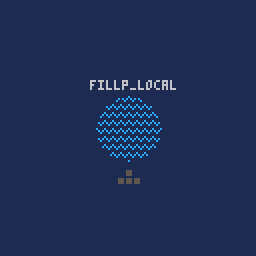
My contributions: I sped it up and saved tokens by using bitwise operators instead of their function equivalents. and various other small things -- e.g. there's no need to mask y before rotating p32, so I removed the y&3 step.
Differences from fillp()'s interface:
- all args are required (p, x, y)
- there is no return value (easy to add back if you want, costs 1 token)
Some notes:
- if you don't need to support fillp's transparency/etc bits, you can save a few more tokens by removing
| p-p16 - the mask calculation (
local mask = split"30583,13107,4369"[x] or -1) is just a token-light + fast way to map x from{0,1,2,3}to{0xffff,0x7777,0x3333,0x1111}. Two other ways you could do it:local mask = split"0xffff,0x7777,0x3333,0x1111"[x+1]-- 91 cycles, same token count. much more readablelocal mask = (15>>x)\1*0x1111-- 34 cycles, +2 tokens- The current method takes 70 cycles, which is twice as slow as the fast way. But I can't imagine that would matter to most people, so I defaulted to the token-light version.
[Please log in to post a comment]






